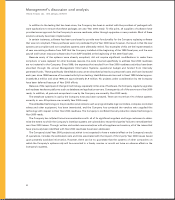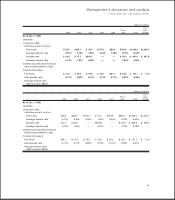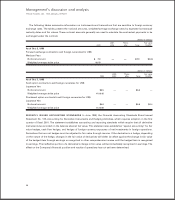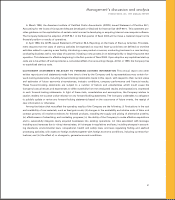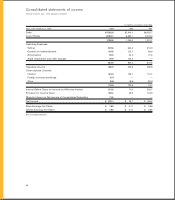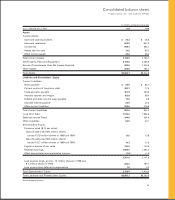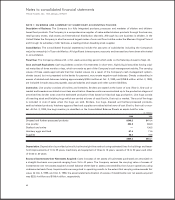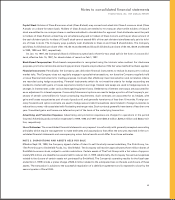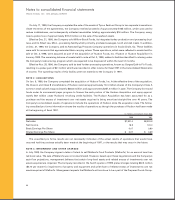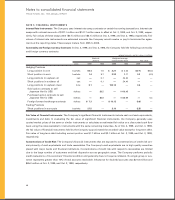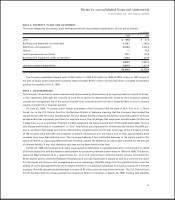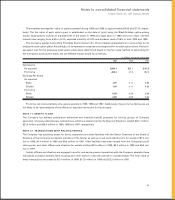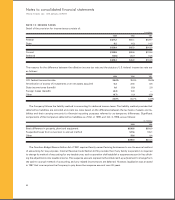Tyson Foods 1999 Annual Report Download - page 44
Download and view the complete annual report
Please find page 44 of the 1999 Tyson Foods annual report below. You can navigate through the pages in the report by either clicking on the pages listed below, or by using the keyword search tool below to find specific information within the annual report.
Notes to consolidated financial statements
TYSON FOODS, INC. 1999 ANNUAL REPORT
42
NOTE 1: BUSINESS AND SUMMARY OF SIGNIFICANT ACCOUNTING POLICIES
Description of Business: The Company is a fully integrated producer, processor and marketer of chicken and chicken-
based food products. The Company is a comprehensive supplier of value-added chicken products through food service,
retail grocery stores, club stores and international distribution channels. Although its core business is chicken, in the
United States the Company is also the second largest maker of corn and flour tortillas under the Mexican Original®brand
and through its subsidiary Cobb Vantress, a leading chicken breeding stock supplier.
Consolidation: The consolidated financial statements include the accounts of subsidiaries including the Company’s
majority ownership in Tyson de Mexico. All significant intercompany accounts and transactions have been eliminated
in consolidation.
Fiscal Year: The Company utilizes a 52- or 53- week accounting period which ends on the Saturday closest to Sept. 30.
Cash and Cash Equivalents: Cash equivalents consist of investments in short-term, highly liquid securities having origi-
nal maturities of three months or less, which are made as part of the Company’s cash management activity. The carrying
values of these assets approximate their fair market values. As a result of the Company’s cash management system,
checks issued, but not presented to the banks for payment, may create negative cash balances. Checks outstanding in
excess of related cash balances totaling approximately $135.4 million at Oct. 2, 1999, and $158.8 million at Oct. 3, 1998,
are included in trade accounts payable, accrued salaries and wages and other current liabilities.
Inventories: Live poultry consists of broilers and breeders. Broilers are stated at the lower of cost (first-in, first-out) or
market and breeders are stated at cost less amortization. Breeder costs are accumulated up to the production stage and
amortized into broiler costs over the estimated production lives based on historical egg production. Live hogs consist
of breeding stock and finishing hogs which are carried at lower of cost (first-in, first-out) or market. The cost of live hogs
is included in cost of sales when the hogs are sold. Broilers, live hogs, dressed and further-processed products,
seafood-related products, hatchery eggs and feed and supplies are valued at the lower of cost (first-in, first-out) or mar-
ket. At Oct. 2, 1999, live hog inventory is classified on the Consolidated Balance Sheets as assets held for sale.
in millions
1999 1998
Dressed and further-processed products $549.2 $410.4
Live poultry 290.8 286.9
Seafood and swine —136.5
Hatchery eggs and feed 67.4 71.5
Supplies 82.0 78.8
$989.4 $984.1
Depreciation: Depreciation is provided primarily by the straight-line method using estimated lives for buildings and lease-
hold improvements of 10 to 39 years, machinery and equipment of three to 12 years, vessels of 16 to 30 years and other
of three to 20 years.
Excess of Investments Over Net Assets Acquired: Costs in excess of net assets of businesses purchased are amortized on
a straight-line basis over periods ranging from 15 to 40 years. The Company reviews the carrying value of excess of
investments over net assets acquired at each balance sheet date to assess recoverability from future operations using
undiscounted cash flows. Impairments are recognized in operating results to the extent that carrying value exceeds fair
value. At Oct. 2, 1999, and Oct. 3, 1998, the accumulated amortization of excess of investments over net assets acquired
was $225.4 million and $196.4 million, respectively.


